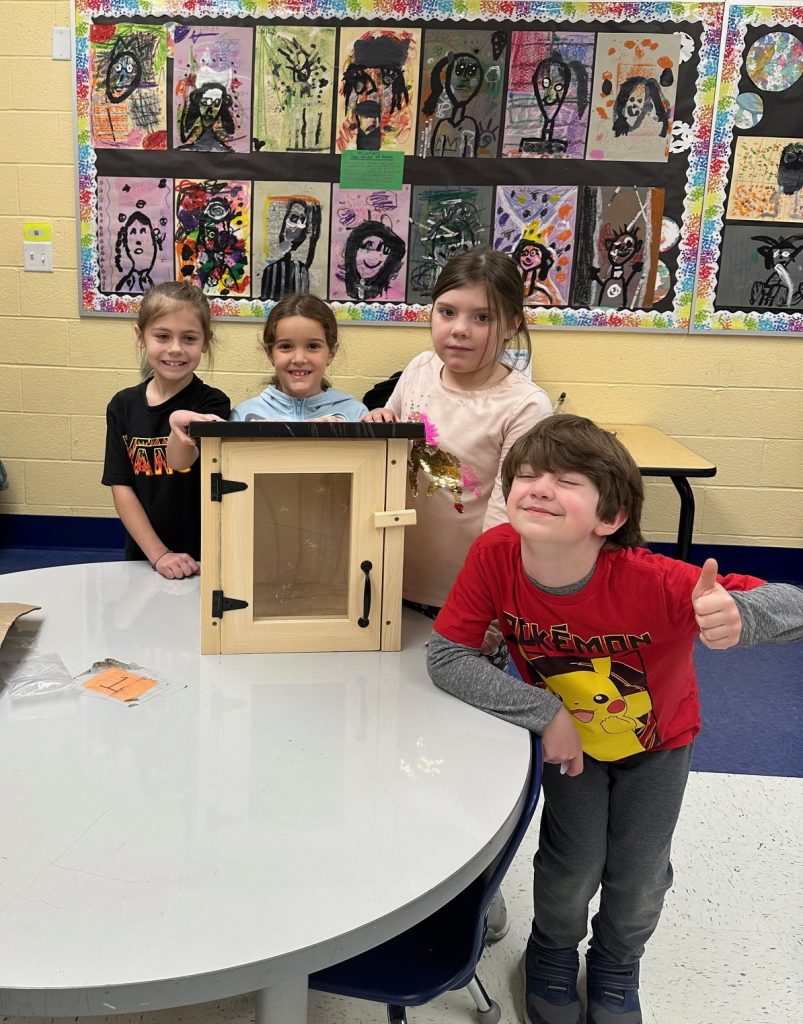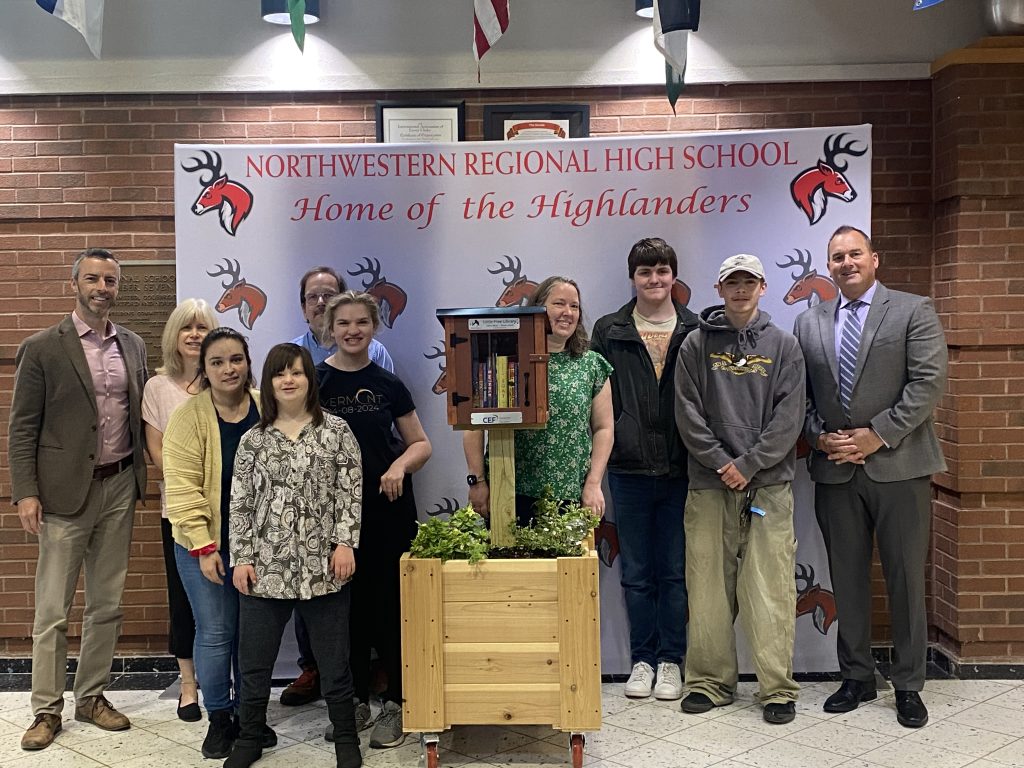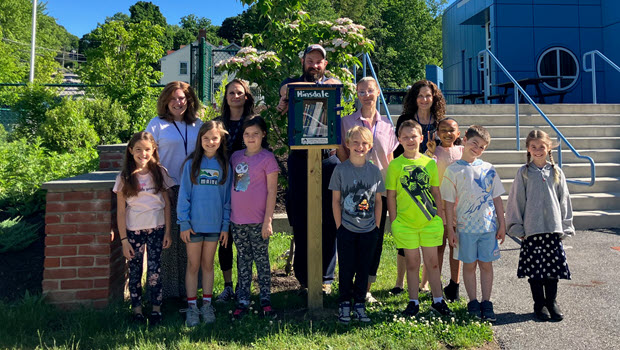The Connecticut Education Foundation (CEF), CEA’s charitable arm, added new elements this year to its beloved Read Across Connecticut literacy campaign. One of those initiatives—Little Free Library kits and books to fill them—was designed to broaden the program’s reach.
“We want to expand access to children’s books in every city and town every day of the year,” says CEF President and CEA Vice President Joslyn DeLancey, “and we liked the idea of Little Free Libraries. CEA members were eager to work with students on customizing and selecting the best locations for them.”
Little Free Libraries are a book exchange program and a hub for community engagement and sharing. The wooden repositories are built by volunteers, typically installed in public spaces, and filled with free books for readers to enjoy.
CEF provided Little Free Libraries, as well as books to fill them, to dozens of members across the state who requested them.
“While our kits were out being assembled by teachers and students, including members of CEA-Retired and the CEA Aspiring Educator Program, we were also hosting a community book drive to collect as many picture and chapter books, novels, nonfiction titles, and early readers as possible for our Little Free Libraries,” says DeLancey. The book drive—held in honor of Dr. Seuss’s birthday—received thousands of donations across genres and reading levels, all of which have been distributed to schools around the state, including many Alliance District schools.
Under construction
Westhill High School English teacher Kate Tobin says Stamford’s new Little Free Library has been greeted with tremendous enthusiasm by students and teachers alike.

Winsted students are excited about their new library.
“We are so excited that students will be able to share a love of reading with one another by donating and taking books,” she says, “and the kids working on it have been hyped about having a clear community service project to engage in.”
“In our school, we promote a culture of reading, and we want to get students excited about it,” says Derby literacy coach Nicole Mastroianni, whose students are in the process of painting their Little Free Library. “As we transition to a new art teacher, our goal is to have our library up and running in the fall. We can’t wait!”
Noting that many Farmington schools already have Little Free Libraries, Kenneth Ives was eager to install one on the grounds of West Woods Upper Elementary, where he teaches.
“They’re great, and our administrator thought it was excellent that we were adding one.”
In Wallingford, where Little Free Libraries can be found at all eight schools as well as in parks and outside of businesses and homes, Wallingford Education Association President Anne Varrone-Lederle requested books from CEF’s book drive to keep the town’s libraries well stocked.
“I will never turn down the chance to get more books to our students and residents,” the Moran Middle School foreign language teacher says.
Hands on, minds on
“Our school’s library and art enrichment students assembled and painted our Little Free Library, which was installed at Hinsdale School in the late spring, once the ground thawed,” says Winsted reading specialist Marissa Rosenfield. “Our goal is to put more books in the hands of Winsted students, and everyone’s excited to see the library up and running!”
“I run the Youth Entrepreneurs Club at Torrington Middle School, and I thought it would be a great project for our students to complete,” says Stacey Pollock. “Our seventh-graders have been staining and constructing the library, and it’s been fun watching their progress! It will be outside our school and accessible not only to students but also community members attending events at our building.”

Northwestern Regional High School designed a mobile Little Library that can be moved inside or out depending on the weather.
Northwestern Region 7 LINKS Program special education teacher Megan Ficke was also excited to learn about CEF’s Little Free Library project.
“Since I teach students with a wide range of exceptionalities,” she says, “I work closely with staff, classroom teachers, and related service providers to find activities and tasks that are meaningful and provide an opportunity for my students to gain or show their skills while working with their peers. I immediately thought of the construction class at our high school.”
Because the Little Free Library came as a kit modified to avoid cutting materials, Ficke points out that students achieved a sense of accomplishment when they put it together with simple tools.
“I knew it would give them opportunities to work on communication skills and collaborate with others while following specific directions. In addition, it was a larger item, similar to projects that students in their construction class were completing at that time. I requested the kit as well because our building likes to find ways to give back. This Little Free Library would continue to be a task that my classroom students could work on, monitoring usage and taking care of the library. It would give them another opportunity to be responsible and contribute to our school community.”
Located on the school’s campus, the library will be mobile so that it can be placed indoors or out, depending on the season or need, says Ficke.
“Our school district serves students from Colebrook, Norfolk, Barkhamsted, and New Hartford, and we have students from other schools who participate in our agricultural program. We mounted the post into a planter and collaborated with our agricultural program to add flowers and other decorative plantings.”







